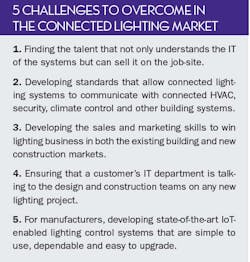At last year’s IoT Emerge Event in Chicago, I moderated a panel of six senior lighting executives on connected lighting —“The Real Deal on Smart Lighting: How IoT is Transforming Today’s Lighting Market.” Their hour-long discussion touched on many of the key drivers changing the lighting market and pushing it toward a more connected future. This article offers some intriguing insight into their fascinating discussion on the future of smart lighting.
The Transition to LEDs: Moving Fast But Not Without Some Stumbling Blocks
Although it seems like LEDs have been around forever, the panelists agreed most lighting systems still utilize traditional lighting technology. While the lighting execs on the panel are big believers in the potential of connected lighting, they were realistic about how much work needs to be done in converting existing lighting system to LEDs before connected lighting even starts to be implemented on a widespread basis. Gary Trott, V.P. of Marketing, Intelligent Lighting, Cree, Durham, NC, said only 10% of lighting systems in existing buildings in the United States are powered by LEDs, but that 70% of new construction uses LED technologies. Ken Walma, V.P. and general manager, Ambient & Controls Solutions, Eaton–Lighting, Peachtree City, GA, said the percentage of LEDs in existing buildings globally is even lower, at about 3%. He agrees with Trott that only after the installed base has been converted over to LEDs will we see connected lighting systems really take off.
“One of the benefits is the sheer number of nodes that will be out there. You are talking about billions of connected devices,” Walma said. “People know what’s coming, but they are still not sure what they can do with that data. We look at the number of buildings out there that have a person who wants to do something with that data. It’s probably less than 1%. How do we convert that benefit story so more people are interested in doing it?”
As the lead executive of an energy service company (ESCO), Christopher Gersch, founder, Verde Solutions, Chicago, Ill., talks with CFOs all the time about the impact of an energy-efficient lighting retrofit. His larger customers with multiple facilities, like Goldman Sachs and Genuine Parts, are already aggregating their total electrical demand and want IoT-enabled systems designed for multi-location analytics so they can analyze their energy data and negotiate with energy providers on methods of reducing their costs. “It seems like customers and buying influences in the market are just starting to get their minds around the potential of connected lighting,” said Gersch.
Eaton’s Walma said another challenge is that although LEDs have opened up a huge retrofit business, many lighting manufacturers and their channels to market are not equipped to handle it because they focus more on new construction. “It’s $600 billion $700 billion to build new buildings every year, and that has somewhat slowed,” he said. “The renovation side is nine times that market, but it has left many manufacturers somewhat flatfooted in trying to call on these new people and actualize the potential of this value proposition. Spec firms may not be involved to the same level. And it has been a big challenge from a channel perspective.”
The Need for IT Talent
The lighting market seems like it’s been in a constant state of technological change over the last few decades. But the panelists agreed that the software developers and other techies in the IT world never thought about a career in lighting until they started hearing about the development of smart lighting systems that will link lighting fixtures to building management systems and billions of other nodes via the Internet of Things (IoT).
Eric Lind, sales vice president, Strategic Commercial Accounts, Lutron Electronics Co., Coopersburg, PA, said more and more new hires at Lutron have a background in software development. He said lighting was never considered a tech industry until the last few years.
Eaton’s Walma said his company’s lighting business has been hiring tech talent from “every tech company you can imagine,” and that many of the software developers and other new employees want to work in lighting because of massive opportunity available in upgrading existing lighting fixtures with LEDs and connected lighting systems. “Very few other industries in the world have a fixed infrastructure that is going to be touched in every home and every building in every city in the next 10 years,” he said. “That change-out has created a very attractive proposition for some of the most technology-rich people in the world.”
Cree’s Trott said the type of people his company hires is very different from several years ago and includes data scientists, software and firmware specialists. “All these people must work together to create a solution that is so simple the people installing it and using it don’t have to have that level of sophistication,” he said. “It’s very hard to make something simple and that’s what the challenge is.”
There’s no doubt that the challenge and expense of hiring new IT talent is changing the lighting game, and Chris Gersch is looking for engineers with at least one-to-two years of experience to join Verde Solutions. Gersch is an adjunct at University of Chicago and tries to recruit his best students whenever possible to work on projects across the United States. Verde Solutions currently has two in-house installation teams and about eight outside contractors working on 40-plus projects nationwide.
“We are looking for installation crews who are local but have the scalability to work in a region or several states,” he said. “We have approximately eight firms that we use. For an ESCO to do everything in-house, it gets very expensive and we would go out of business very quickly.”
With his background in executive recruitment and lighting, Ted Konnerth, president and CEO, Egret Consulting, Mundelein, IL, has a unique perspective on the job skills needed in the new world of connected lighting. He believes finding new employees with a mix of IT knowledge and job-site sales skills will be challenging but necessary. The crux of IoT is the skill set, he said. “That includes the highest level leadership down to where the rubber meets the road with installers. We are at an inflection point where there are channel barriers of adoption. IoT is going to add even more stress to them. Candidly, I think there is an emerging channel that could come out that would have the technical skills to do that.
“My biggest fear is what happens to lighting. Lighting is a specially designed feature that has a technical side and a sense of art to it. There aren’t many people who have the business acumen of the people on this panel, but can also go to a contractor or distributor’s office and actually sell it.”
Power over Ethernet (PoE) – The Potential to Cut Installation Costs and Drive IoT Connectivity
PoE systems have been around for years, and Himanshu Mehra, senior manager, Product Management, Switching and IoT Platforms, Cisco, said his company has used PoE in its switching infrastructure with phones, access points and wireless for several years. The panelists from Cisco, Cree and Eaton said their companies are all working intensely on PoE. Eaton displayed its PoE at Lightfair this year in San Diego and promoted not only the simplicity of its Distributed Low Voltage Power (DLVP) lighting system but the 20% savings it produces over conventional wiring methods. Driving home the point on the revolutionary nature of this technology at Eaton’s Lightfair booth were several plexiglass container walls loaded with the conduit, flexible cable whips and related conventional wiring products that the DLVP system replaced. The DLVP system utilizes a technology similar to PoE and is based on the same Underwriter’s Laboratory (UL) and National Electric Code (NEC) requirements for Class 2 low-voltage systems.
Cree’s Trott said the key driver for PoE’s adoption is how simple it is to install. “It’s easier for the user, and the best technology is the one that is used. Simplicity drives adoption.”
“Technology is only successful when it adapts to an industry,” agreed Cisco’s Mehra. “IoT as a platform won’t be successful unless it adapts to lighting. You will see smart lighting as an industry when the technology is simple enough and mature enough to adapt to the skill set of the people installing it.”
Challenges to Adoption of Connected Lighting
While everyone on the panel applauded the benefits and potential of LEDs and IoT, they said some basic hurdles must be overcome before these technologies achieve widespread adoption in the lighting market.
Lutron’s Eric Lind said one of the biggest challenges is platform convergence. “On the LED side, we don’t have standards that are that well entrenched. I do think that affects adoption.”
Egret Consulting’s Ted Konnerth said the lighting market is still in 1.0 on IoT. “We are still in that stage of confusion on how integrated they want to be. The adoption of IoT is riding on the shoulders of an energy reduction story. If you can sell it on the energy savings of converting over to IoT, you can couple it with the advantages of IoT.
“I am kind of a granular guy,” he said. “If we went around the room and asked the lighting manufacturers what percent of their revenues is accounted for by connected lighting and PoE, it would not show. It’s early stage. There’s lots of work to be done in standards and interconnectability.”
Eric Lind of Lutron believes teamwork and communication between the design, construction and IT teams on connected lighting projects will be absolutely critical. “I believe the design teams and the construction teams need to get the IT teams involved with clients,” he said. “They have not typically been part of any narrative done in buildings. Now they must not only understand what they want to do with information from the IoT perspective but also enable it. Those same IT people can fundamentally block great ideas if they are overly conservative. This can change a project from being an IoT-enabled project to just being a lighting project.”
Meet the Panelists
Himanshu Mehra
Cisco
San Francisco Bay Area
As one of the first members of Cisco’s Digital Ceiling initiative Mehra is responsible for driving Cisco’s Digital Ceiling vision, strategy and roadmap. He has several years of experience in various engineering, marketing and business development roles and holds an MS in Computer Science from the University at Buffalo and an MBA from UCLA Anderson.
Christopher Gersch
Verde Solutions
Chicago, Ill.
Gersch founded Verde Solutions, an energy consultant firm focused on bringing new technologies and cost-saving solutions to commercial, municipal and residential facilities across the country through on-site utility audits. Verde Solutions has grown over 300% per year with its smart lighting solutions. The company has 26 full-time lighting professionals and is a preferred energy consultant for firms including GPC (Napa Auto Parts, Motion Industries), Goldman Sachs and Centerpoint Properties. In addition to managing Verde Solutions, Gersch is an adjunct instructor at the University of Chicago and teaches quantitative trading strategies and algorithmic system modeling. He also has extensive experience in the investment industry and in several other web-based businesses.
Gary Trott
Cree
Durham, NC
In his 20-year career, Gary has worked for Cree in number of senior executive positions and been awarded several lighting patents. In his LinkedIn profile, Gary says he is “a product development innovator and technologist for Cree with a passion for driving the development of breakthrough lighting products that change the way we light the world.”
Ken Walma
Eaton – Lighting
Peachtree City, GA
As V.P. and general manager for this division, Walma is responsible for the overall success, growth, and profitability of lighting solutions within Eaton’s Ambient Lighting and Global Controls platforms. This includes leading the overall definition, strategy, and execution of Eaton’s largest lighting product line and the indoor controls business.
Eric Lind
Lutron Electronics Co. Inc.
Coopersburg, Pa.
Lind is responsible for the Lutron interface to the lighting design community and corporate relationships with two industry groups – the Illuminating Engineering Society (IES) and the International Association of Lighting Designers (IALD). He is also part of team that defines the commercial product portfolio road map for Lutron. He joined Lutron as a marketing engineer and has served in several other roles, including sales supervisor for lighting showrooms, specification sales manager, and market development manager. As an IES member, Lind has worked on several advisory boards that established content and speakers for Lightfair, IES and IALD conferences.
Ted Konnerth
Egret Consulting
Mundelein, Ill.
Konnerth is a well-known presence in the lighting industry through his years of experience as a senior executive with a major lighting company, the speaking and blogging that he does on the lighting industry, and through Egret Consulting, the electrical market’s largest executive search firm.
Moderator: Jim Lucy, Chief Editor, Electrical Wholesaling magazine
About the Author
Jim Lucy
Editor-in-Chief of Electrical Wholesaling and Electrical Marketing
Jim Lucy has been wandering through the electrical market for more than 40 years, most of the time as an editor for Electrical Wholesaling and Electrical Marketing newsletter, and as a contributing writer for EC&M magazine During that time he and the editorial team for the publications have won numerous national awards for their coverage of the electrical business. He showed an early interest in electricity, when as a youth he had an idea for a hot dog cooker. Unfortunately, the first crude prototype malfunctioned and the arc nearly blew him out of his parents' basement.
Before becoming an editor for Electrical Wholesaling and Electrical Marketing, he earned a BA degree in journalism and a MA in communications from Glassboro State College, Glassboro, NJ., which is formerly best known as the site of the 1967 summit meeting between President Lyndon Johnson and Russian Premier Aleksei Nikolayevich Kosygin, and now best known as the New Jersey state college that changed its name in 1992 to Rowan University because of a generous $100 million donation by N.J. zillionaire industrialist Henry Rowan. Jim is a Brooklyn-born Jersey Guy happily transplanted with his wife and three sons in the fertile plains of Kansas for the past 30 years.







